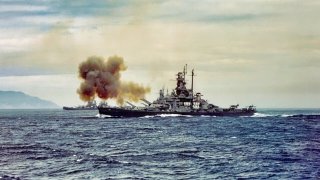USS Indiana: This U.S. Navy Battleship Was a True Pacific Terror
The Indiana spent her entire service career in the Pacific, where she was involved in nearly every major campaign during World War II.
In the 1920s, five major nations with a heavy interest in maritime security tried to prevent an arms race. The United States, United Kingdom, France, Italy, and Japan set out to limit how much tonnage they could build and which armaments their ships could equip.
The resultant Washington Naval Treaty was somewhat effective for a time. But by the 1930s, Japan and Italy were in the grip of expansionist fervor, and the treaty fell apart. As the other signatories sought to keep up with their adversaries’ expanding navies, they took advantage of escalator clauses within the treaty that allowed them to build larger vessels. For the U.S. Navy, this took the form of South Dakota-class battleships. The second of these, the Indiana, was completed in November 1941 and officially entered service in April of the following year.
The Indiana spent her entire service career in the Pacific, where she was involved in nearly every major campaign during World War II.
Specs & Capabilities
The Indiana was specifically designed with the treaty’s escalator clauses in mind. She was 680 feet long and displaced around 35,000 tons, the same as her predecessors, but she had a much heavier armament, boasting nine 16-inch guns on three turrets: two forward, one aft. She also mounted twenty 5-inch guns in twin turrets amidships, five turrets to a side. Her original anti-aircraft complement was upgraded to seven 40mm Bofors guns and thirty-five 20mm Oerlikon cannons.
The spaces below were rather small due to the 12.2-inch armored belt, another upgrade facilitated by the Washington Naval Treaty’s escalator clauses. Over the years of war, she would add another thirty 40mm guns. These would prove essential to her mission of providing anti-aircraft support, but the crew added to service these guns made the confined spaces below even more cramped. From her initial complement of 1,793 crew, by the end of the war, she was embarking 2,500 men.
Operational History
Upon commissioning, the Indiana was swiftly dispatched to participate in operations in the Pacific. She first fired her guns in anger in December of 1942 in support of Marine forces engaged on Guadalcanal.
Throughout 1943 and into early 1944, the Indiana carried out a variety of missions, from convoy escort to supporting carrier strike groups, to protecting the fleet from potential Japanese attack. She shot down several aircraft and participated in naval gunnery support on the islands of Nauru and Kwajalein. On Feb. 1, 1944, she collided with the battleship USS Washington, resulting in four dead crewmen and significant damage to her propeller and torpedo belt.
Twenty feet of the Washington’s bow was left lodged in the Indiana. Following repairs in Pearl Harbor, the Indiana participated in the remaining major campaigns of the war. She was present at Iwo Jima and Okinawa and even raided the Japanese home islands. Through it all, her crew fired the 16-inch guns in support of troops ashore and shot down multiple aircraft.
After the war, she was retired to the reserve fleet. Over the next decade, plans were proposed that would have converted her to a guided-missile battleship, all her guns replaced with missile launchers. The idea was too costly and was scrapped. On June 1, 1962, she was stricken from the Naval Vessel Registry and sold for scrap. Several components, including an anchor, the wheel, and the ship’s bell have been preserved at various sites in her namesake state, Indiana.
About the Author: Maya Carlin
Maya Carlin, National Security Writer with The National Interest, is an analyst with the Center for Security Policy and a former Anna Sobol Levy Fellow at IDC Herzliya in Israel. She has by-lines in many publications, including The National Interest, Jerusalem Post, and Times of Israel. You can follow her on Twitter: @MayaCarlin.

